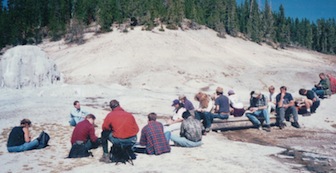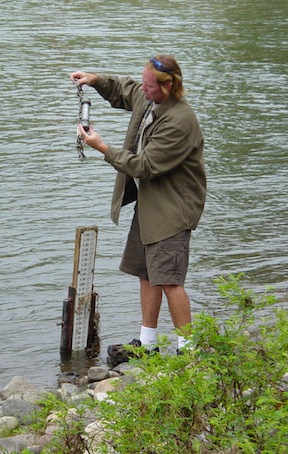Idaho State University chemistry department develops smartphone app for Yellowstone field trips
November 4, 2014
Idaho State University’s environmental chemistry class takes an annual field trip to Yellowstone National Park to investigate the unique geothermal features of the park. This year the chemistry department launched both a website and app giving more information on the chemistry of the three basic types of geothermal springs.
 The website provides information about chemical reactions that ultimately shape the springs into terraces, geysers, and mud volcanoes, and the app allows students on the trip to record their sampling information, including pictures, of each site they visit. The app automatically displays the sampling site on Google maps, loads physical and chemical information concerning that site, and displays photos of the area.
The website provides information about chemical reactions that ultimately shape the springs into terraces, geysers, and mud volcanoes, and the app allows students on the trip to record their sampling information, including pictures, of each site they visit. The app automatically displays the sampling site on Google maps, loads physical and chemical information concerning that site, and displays photos of the area.
With 15 students all working at once, accurately disseminating the information each student collects to the rest of the class used to be difficult. Now, using their smart phones, the students are able to load their individual data onto the app which displays the information on the website.
The app was ISU chemistry Professor Jeffrey Rosentreter’s idea and was designed by Jeff Kuhlmeier, a chemistry undergraduate student who also has an aptitude for computer science.
“Without Jeff this thing wouldn’t have gotten done,” said Rosentreter.
“The whole process was made possible in a short amount of time thanks to Open Data Kit for data collection, and Google’s API’s for data aggregation and presentation,” said Kuhlmeier.
Another useful feature of the app is that it is able to store data temporarily on phones. The lack of cell service in some areas of the national park makes it necessary to house the data on the phone’s memory until cell service becomes available again. The process is seamless, so no information gets lost and users don’t have to resend data.
“It was a great experience to see the how the tools I brought together being used by the Environmental Chemistry class,” said Kuhlmeier. “They enjoyed putting it through its paces and providing feedback for improvement.”
The app also has potential to be used in different classes and fields of study.
 “It’s set up to use in any field-sampling situation. I could see it ecology, biology, geoscience, even anthropology,” said Rosentreter. “One thing is we are time-limited in Yellowstone. It much easier for students to enter data with this app. It’s so much more organized.”
“It’s set up to use in any field-sampling situation. I could see it ecology, biology, geoscience, even anthropology,” said Rosentreter. “One thing is we are time-limited in Yellowstone. It much easier for students to enter data with this app. It’s so much more organized.”
The app has allowed the chemistry field trips to gather more accurate data while saving time at each sampling site.
“With some of the sites a bit off the beaten path, we need to keep moving to get our work done,” said Rosentreter, “Data logging on mobile devices is fast becoming the norm in the regulatory world, and it’s nice to introduce the student to this quality control sampling now in class.”
Rosentreter believes that this will make chemistry students excited to be a part of the field, as well as attracting new students.
“It’s really launched what we do into the 21st century,” he said.
The app is located at https://sites.google.com/site/isuenvironmentalchemistry/home.
Categories:
